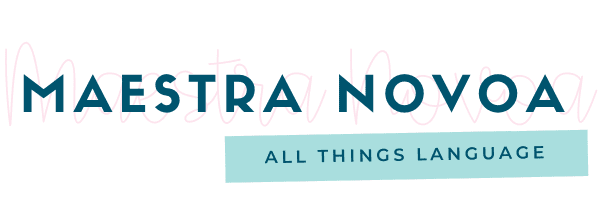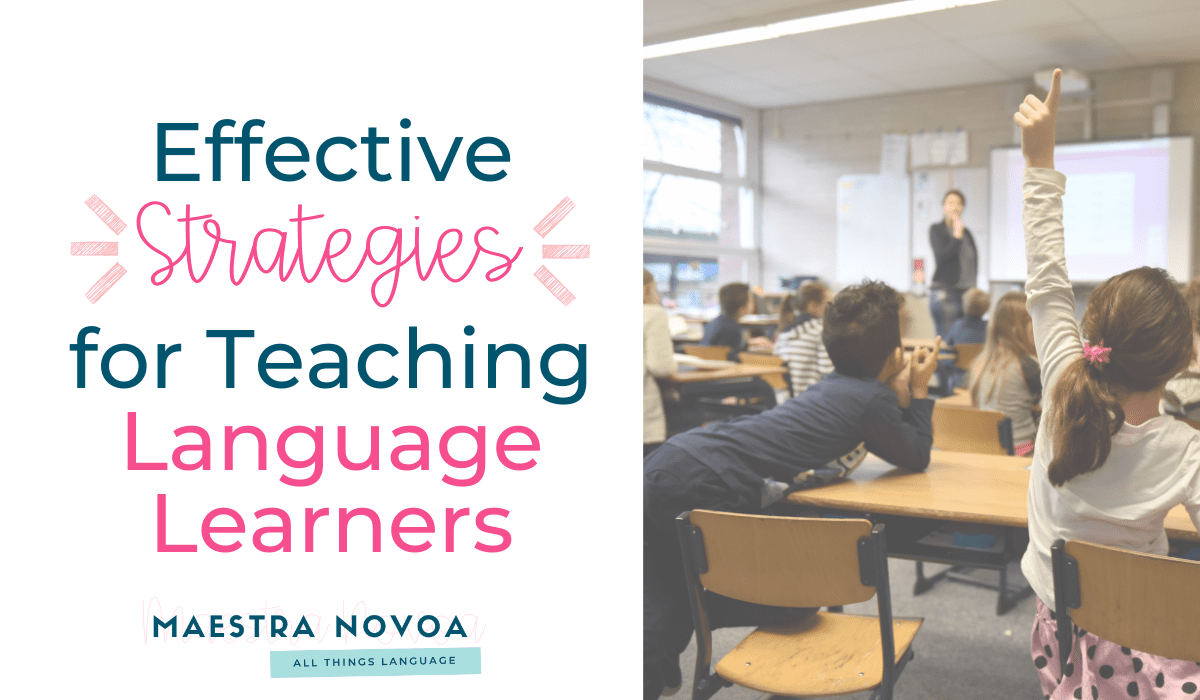These effective strategies for teaching language learners are essential for dual language, co-taught, SIOP classes…honestly any classroom! I say this because ALL students are language learners, even if they are learning English at school AND only use English at home.
As a language teacher, it is essential to provide learners with the necessary tools and techniques to help them achieve their language learning goals. Language experts Freeman and Freeman wrote, “Even though the school may not refer to these teachers [classroom and content teachers] as language teachers, that is what they are.” This post is going to be useful for ALL teachers, no matter the content area or grade level.
In this post, we will explore various strategies that have proven to be effective in teaching language learners of all levels. Whether you are a language teacher or a language learner yourself, this post will provide you with valuable insights into the most effective ways to teach and learn a new language.
Sentence Starters and Frames
One quick thing I’d like to share with you before exploring the various language strategies is sentence starters and frames. They are SO easy to use to help students with language production.
Sentence starters and frames are structured sentences that students either complete after you provide the starter or fill in the blanks of the frame. You can use them in any class for basically any assignment where students are producing work. I have a post you can check out here called A Guide to Creating Perfect Sentence Frames and Starters. You can also check out these ready-to-go sentence starters for social studies and math in my TPT store.
Why These Effective Strategies for Teaching Language Learners Matter
I was reading over some notes I took in my first year of teaching and I found some gold nuggets in there. I asked students how their classes were going. At this time, I was trying to learn how to best support language learners in co-taught classes.
What resonated from their answers was that they were overwhelmed. Teachers were going through the content too fast, there were so many words they were trying to learn, and they just felt lost constantly. Their teachers hadn’t been trained to teach novice language learners. The support students needed to feel even a little bit of success wasn’t being provided. No one should have the feeling of constant failure. That is why these strategies are so important.
So, let’s dive in and discover some of the best strategies for teaching language learners!
Language Learner Strategies
Strategy #1 – Use Visual Aids
Incorporate visual aids like pictures, diagrams, and videos into lessons to help language learners understand and retain new vocabulary and concepts. When using visual aids, make sure they are not overwhelming and to the point. Adding arrows and labels is important to make sure the purpose of the visual is obvious.
Strategy #2 – Provide Contextualization
Provide meaningful and relevant contexts for language learners to help them understand the meaning of new words and phrases. How can you do this? Personalizing new words and phrases to learners’ interests and experiences that make the words more relevant and memorable. Here are some examples of different contents:
- Math: Slope has so many real-world examples! Relate it to the decline of a hill when hiking or a ramp incline for accessibility. Check out these for these Multiple Representations of Linear Equations card sort on my TPT store for more examples.
- Science: An example of a unit of Genetics & Heredity would be relating the code in DNA to codes in their daily lives, such as their phone lock codes. A correct code tells the phone to unlock while an incorrect code locks the phone for a longer time. What does the DNA code tell our bodies? Simple, yet relative metaphors are so helpful.
- Social studies: Studying the leadership of Napoleon? Give examples of leaders in their life: teachers, family members, local government, etc., and hook them with what characteristics make a good leader.
Another great way to do this is by planning cross-circular lessons. Students in English class were working on their research skills for presentations on various topics of the Holocaust while learning about other parts of World War II in social studies class.
Strategy #3 – Encourage Active Participation
Encourage learners to actively participate in the learning process by asking questions, answering prompts, and engaging in group discussions. It’s still our job as teachers to motivate students to learn which can get tough from time to time. My admin shared two great articles with me about this. You can check them out here and here. I like to think of my self as a classroom cheerleader for my students. 🤗

Strategy #4 -Use Simple Language At First
Use simple and clear language, especially when introducing new concepts or ideas. There is no need to add fluff. I know I get lost when people include information that isn’t directly relevant to what they are speaking about. More complex language should be added on as the unit/content is taught.
This is also a great way to develop students’ vocabulary. Once you establish a foundation, students can start building off of it for a more complex and diverse vocabulary. For example, in my Spanish social studies class students knew what a ciudad (city) and pueblo (town) wwereso I used those words to teach them aldea (village).
Strategy #5 -Provide Feedback
Give feedback to language learners, both positive and constructive, to help them improve their language skills. Using the WIDA standards for guidance always helps me! Here are the 6-8 Can Do Descriptors and the 9-12 Descriptors.
An easy way to give feedback is by providing students with clear language and learning targets. This helps students know what they should be learning and how they should produce proof. This blog has some easy-to-use strategies for giving corrective feedback to language learners.
Strategy #6 – Focus on Speaking
Focus on developing speaking skills, as this is often the most challenging aspect of learning a new language. Encourage learners to speak as much as possible during class. Yes, your class might get a little loud, but that’s okay. 🤗
Different ways to give speaking opportunities in your class would be:
- Sharing of initials thoughts with a partner
- Structured partner talk
- Group tasks
Strategy #7 – Provide Opportunities for Practice
Provide ample opportunities for language learners to practice the language in various contexts, such as role-playing, games, and real-life situations. Teach social studies? Check out these modern history simulations for your classroom.
Who are the people who learn how to speak English or any other language? Those who must engage with the language in real-life situations. Real-life situations! Simulations are a recreation of real-life situations which is why they are so memorable and engaging. Language learners are able to experience the usage of language with real-world examples.
Strategy #8 – Incorporate Culture
Incorporate elements of the student’s culture into lessons to help learners better understand the language. This helps relate back to what the student knows. I have a whole post about Creating a Culturally Inclusive Classroom. I promise the tips I share there are practical!
Strategy #9 – Use Multimodal Learning
Use a variety of materials, such as audio, visual, and kinesthetic, to accommodate different learning styles. Don’t be afraid to teach the same concept again using a different type “avenue”! I mentioned earlier that these strategies are helpful for ALL learners. Using multimodal learning is a common practice since we all have different styles of learning. I love this graphic from Tejeda’s Totsblog post about differny learning styles.
Strategy #10 – Create a Positive Learning Environment
Creating a positive learning environment is essential because it can greatly impact a student’s academic performance, behavior, and overall well-being. When students feel comfortable and supported in their learning environment, they are more likely to engage in learning activities, participate in class discussions, and ask questions. This leads to better academic and language outcomes, as students who are actively engaged in learning tend to retain information better and have a better understanding.
A positive learning environment also helps to foster a sense of community and belonging among students. Most language learners are in a whole new country, already feeling like outsiders. When students feel connected to their peers and teachers, they are more likely to feel supported and encouraged to succeed. Everyone should feel welcome. Additionally, a positive learning environment can help to promote positive behaviors and reduce negative behaviors. When students feel safe and respected in their learning environment, they are less likely to engage in disruptive or negative behaviors that can disrupt the learning process for themselves and others.
More Langauge Tips for your Classroom
These effective strategies for teaching language learners are a great place to start meeting the needs of your language learners. When you’re ready for more language tips and strategies, remember I am your girl! Sign up for my email list here.
Recap of Effective Strategies for Language Learners
These effective strategies for teaching language learners are a great place to start meeting the needs of your language learners. Effective language teaching requires an understanding of the unique needs and learning styles of each individual language learner. By incorporating these strategies you will create a dynamic and engaging learning environment that fosters language acquisition and development. Additionally, building a supportive and inclusive classroom community can help language learners feel more comfortable taking risks and making mistakes, which is crucial for language acquisition. With these effective strategies for language learners, educators can empower language learners in so many ways!



